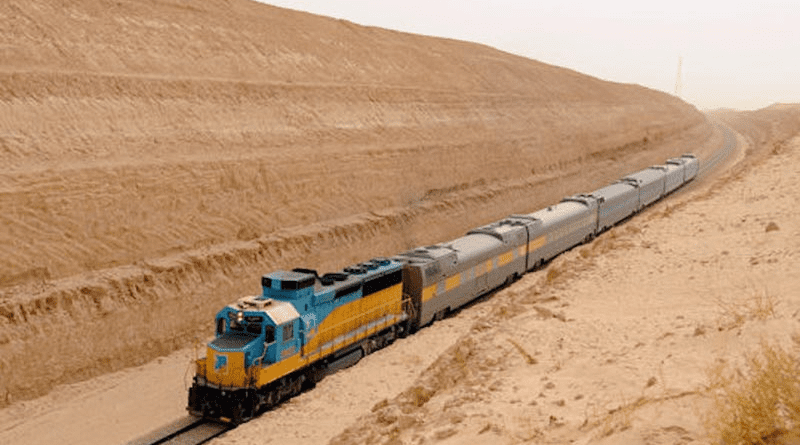Gulf Policymakers Should Let The Train Take The Strain – Analysis
By Arab News
By Luke Coffey*
Construction began in 1903 on a rail line to link Berlin with Baghdad via Constantinople, now Istanbul. Engineering challenges and war meant it was 1940 before the first train completed the journey.
Although the Turks backed the project, it was almost entirely funded by the German government. Germany hoped the rail line would be expanded to connect the port cities of Hamburg and Basra. This would enable Germany to undermine British influence and power in the region while making it easier for Berlin to supply its colonies in East Africa. The cash-strapped Turks welcomed the foreign investment and economic opportunities, and Turkish leaders also saw the rail line as a way to undermine Russian influence in the region.
More than eight decades after the first train from Istanbul pulled into Baghdad Central Station, there is another proposal to connect Turkiye and Iraq by rail. An ambitious project called the Dry Canal corridor is intended to link Iraq’s southern Gulf coast to Turkish ports on the Mediterranean by 2038. Ultimately the goal will be constructing a new rail line and road network linking Grand Faw port, currently under construction 100km south of Basra city, with the Turkish port of Mersin. In addition, there are plans to reopen the rail link that once ran between Mosul in northern Iraq with the Turkish city of Gaziantep. When finished, Grand Faw is expected to be the largest port in the Middle East.
For Turkiye, the benefits of such a rail connection are obvious. President Recep Tayyip Erdogan described the Dry Canal corridor as “the new silk road of our region.” In the past few decades Turkiye has positioned itself as a regional hub for trade, transit, and energy. Its location straddling Europe and Asia offers many advantages. Major shipping routes, oil and gas pipelines, motorways, rail lines, and fiber optic cables spider out from Turkiye and crisscross the region. The proposed Dry Canal corridor is simply the latest example of Turkiye’s emergence as a regional trade hub.
The benefits of the corridor could be significant to the Gulf region too. A rail link connecting the region to the Mediterranean could offer new economic opportunities. If the proposed Gulf Railway connecting the six GCC states by rail ever becomes a reality, the possibilities are great. In theory, it would be possible for goods to be transported from Ad-Duqm port in Oman to the Mediterranean, bypassing both the Strait of Hormuz and Suez Canal.
With creative and ambitious thinking, the Gulf states could even use the Dry Canal corridor to connect to markets in the South Caucasus and Central Asia using the Middle Corridor, a tried and tested trade route connecting Turkiye to Central Asia bypassing Russia and Iran. Currently, there is one main route in the Middle Corridor and a second route is being planned.
The main route connects Turkiye to the Caspian Sea through Georgia and Azerbaijan. This small trade corridor, only 100km wide, is known as the Ganja Gap — named after Azerbaijan’s second-largest city and old Silk Road trading post. Currently, there are major oil and gas pipelines, fiber optic cables, and the Baku-Tbilisi-Kars rail line along this route.
In addition to the Ganja Gap, there is potential for another transport corridor to connect the Gulf via Turkiye, Armenia and Azerbaijan to the heart of Central Asia. As part of the November 2020 ceasefire agreement that ended the 2nd Karabakh War, Armenia pledged to “guarantee the security of transport connections” between Azerbaijan proper and its autonomous Nakhchivan region via Armenia’s Syunik province. As part of this project, there is discussion about modernizing and reopening sections of the old Kars–Gyumri–Nakhchivan–Meghri–Baku rail line. This project, commonly referred to as the Zangezur Corridor, offers potential for transit routes and infrastructure that could also link up to the Dry Canal corridor and the broader Gulf region.
Although railways have been around for more than two centuries, they remain a cost effective, safe, and reliable form of transit in the 21st century. The war in Ukraine has also shown how resilient rail transport is even during modern warfare. Tracks damaged in attacks can be quickly and cheaply repaired. Even with sustained Russian airstrikes, Ukrainian trains had an “on time” average of 85 percent last year.
Like the original Baghdad rail line, there are both geopolitical and economic advantages to the Dry Canal corridor. Gulf policymakers should look closely at ways to better connect the region by rail. In addition to the economic benefits, rail lines offer resiliency for transport. This is especially true as the Suez Canal becomes more congested, and Iran continues to threaten commercial shipping in the Strait of Hormuz. While rail lines will never completely replace cargo ships, transport by train offers another important option for trade. The Dry Canal corridor could be a geopolitical and economic game changer for the region.
• Luke Coffey is a senior fellow at the Hudson Institute. Twitter: @LukeDCoffey

